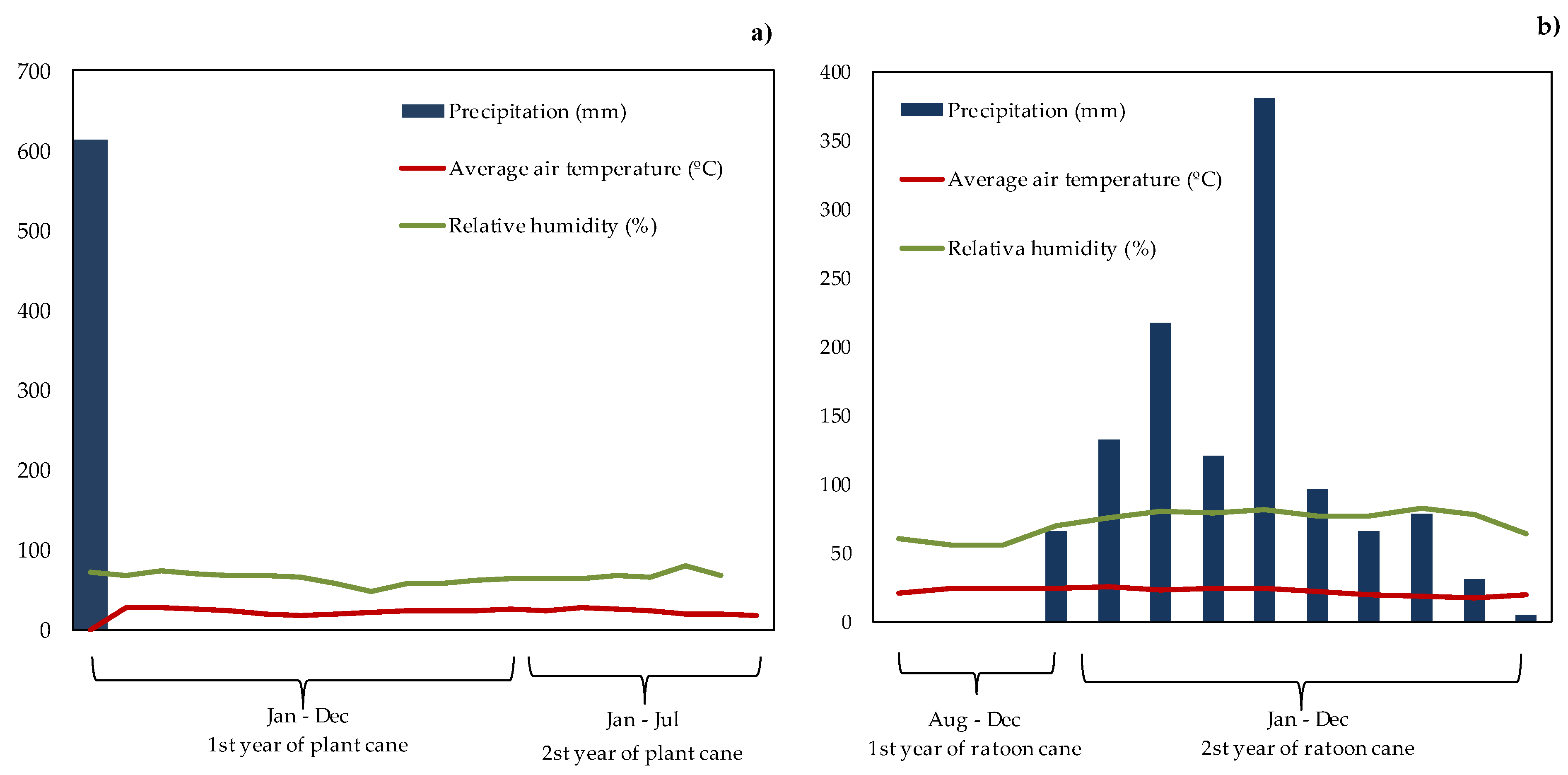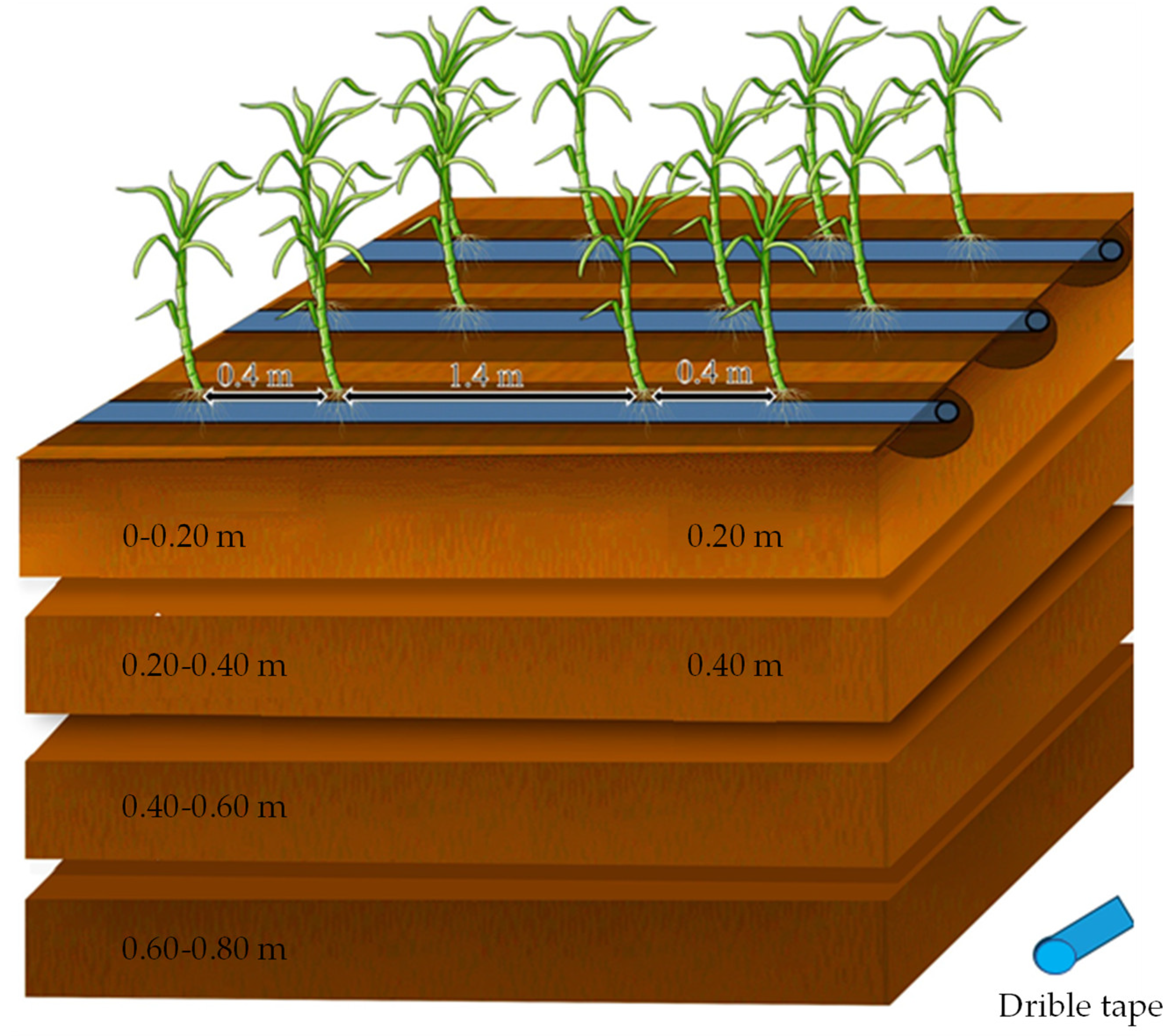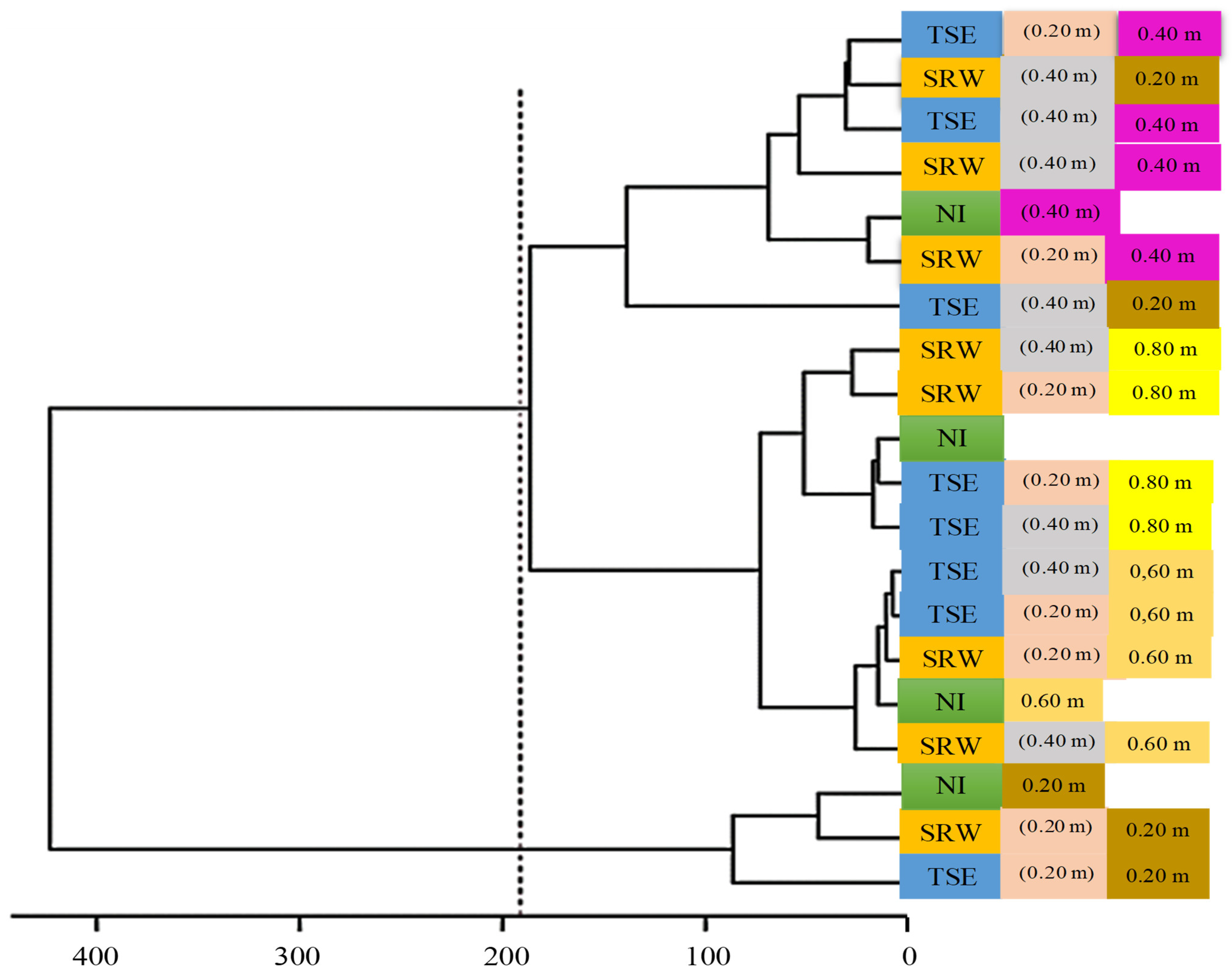Correction: Lopes Sobrinho et al. How Does Irrigation with Wastewater Affect the Physical Soil Properties and the Root Growth of Sugarcane under Subsurface Drip? Agronomy 2024, 14, 788
1. Text Correction
- “Thus, the objective of this study was to evaluate the effects of treated sewage effluent (TSE) or surface reservoir water (SRW), both applied at 0.20 and 0.40 m, via subsurface drip irrigation (SDI), on the root development of first ratoon cane (Saccharum officinarum L.) and the physical properties of dystrophic red latosol.”
- “The plots had the following irrigation treatment water: non-irrigated (NI), irrigated with TSE at 0.20 and 0.40 m, and irrigated with SRW at 0.20 and 0.40 m, being subdivided into the following soil layers: 0–0.20, 0.20–0.40, 0.40–0.60, and 0.60–0.80 m for analysis of soil physical properties and root development in sugarcane plants.”
- The term “types of cultivation” was changed to “irrigation treatment water” to meet a request from the reviewers.
- The term “depth” when referring to soil layers was also removed, as the correct term is “soil layer.”
- To use the correct term, “soil area” has been changed to “soil layers” throughout the text.
- The layer dimensions have been changed from centimeters to meters.
- “In the plant cane, the dripper flow of 1.6 L h−1 had a bandwidth of 0.5 m with a line length of 18 m (17 m of line + 0.5 m at each line end, which corresponds to the whip connection between the derivation and the drip tube).”
2. Error in Figures

3. Error in Tables
| Properties | Units | Averages | CV (1) | Levels (Raij et al., 1996 [33]) |
|---|---|---|---|---|
| pH (H2O) (2) | - | 5.62 | 4.77 | Medium |
| P (3) | mg dm−3 | 19.33 | 24.12 | High |
| S (4) | mg dm−3 | 15.56 | 18.81 | High |
| Na (5) | mg dm−3 | 1.90 | 30.23 | Low |
| K (6) | cmolc dm−3 | 0.57 | 24.66 | High |
| Ca (7) | cmolc dm−3 | 5.10 | 23.69 | High |
| Mg (8) | cmolc dm−3 | 0.94 | 16.83 | Medium |
| Al (9) | cmolc dm−3 | - | - | Low |
| H + Al (10) | cmolc dm−3 | 3.25 | 20.50 | Medium |
| CEC (11) | cmolc dm−3 | 9.87 | 9.79 | Medium |
| V (12) | % | 66.40 | 13.22 | Medium |
| OM (13) | g kg−1 | 37.56 | 10.41 | High |
| EC (14) | dS m−1 | 0.096 | 17.78 | Low |
| ESP (15) | % | 0.083 | 21.62 | Low |
| SAR (16) | mmolc dm−3 | 0.047 | 19.32 | Low |
| Properties | Units | Soil Layers (m) | |||||
|---|---|---|---|---|---|---|---|
| 0–0.20 | 0.20–0.40 | 0.40–0.60 | 0.60–0.80 | CV (6) | General Averages | ||
| pH (1) | - | 5.50 | 5.60 | 5.70 | 5.80 | 3.90 | 5.65 |
| EC (2) | dS m−1 | 0.189 | 0.098 | 0.092 | 0.103 | 53.57 | 0.121 |
| ESP (3) | % | 0.072 | 0.099 | 0.086 | 0.102 | 25.09 | 0.090 |
| SAR (4) | mmol L-1 dm−3 | 0.014 | 0.016 | 0,013 | 0.015 | 19.77 | 0.015 |
| SCAR (5) | - | Normal | Normal | Normal | Normal | - | - |
Reference
- Lopes Sobrinho, O.P.; Santos, L.N.S.d.; Teixeira, M.B.; Soares, F.A.L.; Goncalves, I.Z.; Barbosa, E.A.A.; Nazário, A.A.; Matsura, E.E.; Vitorino, L.C.; Reis, M.N.O.; et al. How Does Irrigation with Wastewater Affect the Physical Soil Properties and the Root Growth of Sugarcane under Subsurface Drip? Agronomy 2024, 14, 788. [Google Scholar] [CrossRef]


| Irrigation Treatment Water | Soil Layers | |||
|---|---|---|---|---|
| 0–0.20 m | 0.20–0.40 m | 0.40–0.60 m | 0.60–0.80 m | |
| Root volume (mm3) | ||||
| TSE(0.20 m) | 193.99 ± 129.09 * Aa | 100.64 ± 64.36 B | 55.48 ± 40.10 BC | 37.60 ± 24.86 C |
| TSE(0.40 m) | 135.14 ± 53.30 Aab | 105.10 ± 89.80 AB | 54.27 ± 28.01 BC | 29.73 ± 17.39 C |
| SRW(0.20 m) | 200.44 ± 84.40 Aa | 120.45 ± 74.34 B | 59.36 ± 29.35 C | 23.15 ± 12.36 C |
| SRW(0.40 m) | 74.83 ± 50.30 Bb | 85.78 ± 80.15 A | 56.70 ± 47.65 AB | 21.71 ± 20.45 B |
| NI | 165.98 ± 124.65 Aa | 125.28 ± 62.71 A | 58.48 ± 38.68 B | 44.13 ± 37.21 B |
| Root area (mm2) | ||||
| TSE(0.20 m) | 1842.46 ± 1018.40 Aa | 879.18 ± 536.63 B | 512.88 ± 337.18 BC | 363.24 ± 172.04 C |
| TSE(0.40 m) | 1245.77 ± 471.19 Aab | 840.35 ± 650.80 AB | 500.36 ± 167.42 BC | 308.91 ± 173.60 C |
| SRW(0.20 m) | 1773.36 ± 663.35 Aa | 977.94 ± 484.56 B | 510.58 ± 170.11 BC | 233.42 ± 84.73 C |
| SRW(0.40 m) | 772.18 ± 498.72 Ab | 704.20 ± 597.28 A | 455.53 ± 363.78 AB | 190.30 ± 137.23 B |
| NI | 1602.06 ± 1047.34 Aa | 1041.88 ± 403.19 B | 501.95 ± 260.11 C | 369.97 ± 230.16 C |
| Root length (mm) | ||||
| TSE(0.20 m) | 2226.39 ± 1145.07 Aa | 994.98 ± 659.46 B | 620.75 ± 411.87 B | 439.98 ± 197.84 B |
| TSE(0.40 m) | 1386.85 ± 577.65 Abc | 876.12 ± 657.91 AB | 613.05 ± 200.95 B | 405.46 ± 237.62 B |
| SRW(0.20 m) | 1938.48 ± 757.73 Aab | 1052.65 ± 421.39 B | 577.84 ± 162.11 BC | 302.98 ± 105.19 C |
| SRW(0.40 m) | 952.09 ± 567.00 Ac | 767.63 ± 578.28 AB | 498.72 ± 395.25 AB | 222.94 ± 118.72 B |
| NI | 1888.55 ± 1167.21 Aab | 1097.96 ± 303.44 B | 558.10 ± 272.46 BC | 418.46 ± 211.90 C |
| Soil density (g cm3) | ||||
| TSE(0.20 m) | 1.23 ± 0.09 BC | 1.39 ± 0.15 Aa | 1.31 ± 0.05 ABa | 1.21 ± 0.03 C |
| TSE(0.40 m) | 1.28 ± 0.09 AB | 1.29 ± 0.12 Aab | 1.19 ± 0.06 BCb | 1.11 ± 0.03 C |
| SRW(0.20 m) | 1.27 ± 0.09 A | 1.25 ± 0.12 ABb | 1.27 ± 0.06 Aab | 1.16 ± 0.06 B |
| SRW(0.40 m) | 1.29 ± 0.08 A | 1.29 ± 0.16 Aab | 1.18 ± 0.08 Bb | 1.16 ± 0.07 B |
| NI | 1.27 ± 0.09 AB | 1.30 ± 0.12 Aab | 1.18 ± 0.08 BCb | 1.16 ± 0.06 C |
Disclaimer/Publisher’s Note: The statements, opinions and data contained in all publications are solely those of the individual author(s) and contributor(s) and not of MDPI and/or the editor(s). MDPI and/or the editor(s) disclaim responsibility for any injury to people or property resulting from any ideas, methods, instructions or products referred to in the content. |
© 2025 by the authors. Licensee MDPI, Basel, Switzerland. This article is an open access article distributed under the terms and conditions of the Creative Commons Attribution (CC BY) license (https://creativecommons.org/licenses/by/4.0/).
Share and Cite
Lopes Sobrinho, O.P.; Santos, L.N.S.d.; Teixeira, M.B.; Soares, F.A.L.; Gonçalves, I.Z.; Barbosa, E.A.A.; Nazário, A.A.; Matsura, E.E.; Vitorino, L.C.; Reis, M.N.O.; et al. Correction: Lopes Sobrinho et al. How Does Irrigation with Wastewater Affect the Physical Soil Properties and the Root Growth of Sugarcane under Subsurface Drip? Agronomy 2024, 14, 788. Agronomy 2025, 15, 2301. https://doi.org/10.3390/agronomy15102301
Lopes Sobrinho OP, Santos LNSd, Teixeira MB, Soares FAL, Gonçalves IZ, Barbosa EAA, Nazário AA, Matsura EE, Vitorino LC, Reis MNO, et al. Correction: Lopes Sobrinho et al. How Does Irrigation with Wastewater Affect the Physical Soil Properties and the Root Growth of Sugarcane under Subsurface Drip? Agronomy 2024, 14, 788. Agronomy. 2025; 15(10):2301. https://doi.org/10.3390/agronomy15102301
Chicago/Turabian StyleLopes Sobrinho, Oswaldo Palma, Leonardo Nazário Silva dos Santos, Marconi Batista Teixeira, Frederico Antônio Loureiro Soares, Ivo Zution Gonçalves, Eduardo Augusto Agnellos Barbosa, Aline Azevedo Nazário, Edson Eiji Matsura, Luciana Cristina Vitorino, Mateus Neri Oliveira Reis, and et al. 2025. "Correction: Lopes Sobrinho et al. How Does Irrigation with Wastewater Affect the Physical Soil Properties and the Root Growth of Sugarcane under Subsurface Drip? Agronomy 2024, 14, 788" Agronomy 15, no. 10: 2301. https://doi.org/10.3390/agronomy15102301
APA StyleLopes Sobrinho, O. P., Santos, L. N. S. d., Teixeira, M. B., Soares, F. A. L., Gonçalves, I. Z., Barbosa, E. A. A., Nazário, A. A., Matsura, E. E., Vitorino, L. C., Reis, M. N. O., & Bessa, L. A. (2025). Correction: Lopes Sobrinho et al. How Does Irrigation with Wastewater Affect the Physical Soil Properties and the Root Growth of Sugarcane under Subsurface Drip? Agronomy 2024, 14, 788. Agronomy, 15(10), 2301. https://doi.org/10.3390/agronomy15102301





